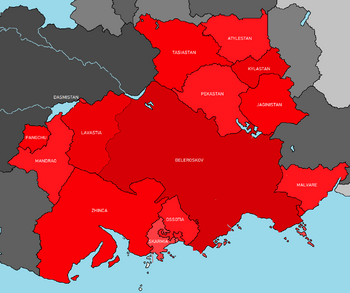United Communist and Socialist States: Difference between revisions
(Created page with "{{Infobox country |native_name = |conventional_long_name = United Communist and Socialist States |common_name = UCSS |image_flag...") |
No edit summary |
||
| Line 9: | Line 9: | ||
|image_map = UCSS_Map.png | |image_map = UCSS_Map.png | ||
|alt_map = | |alt_map = | ||
|map_caption = | |map_caption = The UCSS at its height in 1962 | ||
|capital = [[Koyevka]] | |capital = [[Koyevka]] | ||
|official_languages = [[wikipedia:Russian language|Beleroskovi]] | |official_languages = [[wikipedia:Russian language|Beleroskovi]] | ||
| Line 90: | Line 90: | ||
}} | }} | ||
The '''United Communist and Socialist States''', abbreviated as the '''UCSS''', was a socialist and communist state that spanned much of South-Central [[Ausiana]] from 1905 to 1999. It was nominally a federal union of | The '''United Communist and Socialist States''', abbreviated as the '''UCSS''', was a socialist and communist state that spanned much of South-Central [[Ausiana]] from 1905 to 1999. It was nominally a federal union of 14 national republics; in practice its government and economy were highly centralized until its final years. The country was a one-party state governed by the [[Communist Party of Beleroskov]], with [[Koyevka]] as its capital within its largest and most populous republic, [[Beleroskov]]. Other major urban centers included [[Jaljur]], [[Eterabi]], [[Haruya]], and [[Noboroskiev]]. At its height in 1962, it included the nations of [[Beleroskov]], [[Ossotia]], [[Skarmia]], [[Jaginistan]], [[Tasiastan]], [[Pekastan]], [[Kylastan]], [[Zhinca]], [[Malvare]], [[Atylestan]], [[Pangchu]], [[Mandrao]], [[Dasmistan]], and [[Beleroskov|Lavastia]]. | ||
The UCSS came to be in 1905 after the [[June Revolution of 1905]] when the communists led by [[Joseph Ibilovich]], overthrew the Provisional Government that had earlier replaced the [[House of Lorovav]] of the Beleroskov Empire. Much of central Ausiana began joining the UCSS in the 1930s as expansion of [[Yuan]]'s own system of communism countered with capitalist influence abroad threatened their own ideological influence. The UCSS gained prominence internationally during and following the [[World War (Iearth)|World War]] as its forces participated in military campaigns in [[Haduastan]] and [[Beleroskov]]. In the 1980s, the [[Jaginistan Civil War|civil war]] in [[Jaginistan]] and the [[Ossotia War|suppression of revolution]] in [[Ossotia]] helped stir dissent within the UCSS and on 17 March 1999 the individual states of the UCSS seceded en-masse. | The UCSS came to be in 1905 after the [[June Revolution of 1905]] when the communists led by [[Joseph Ibilovich]], overthrew the Provisional Government that had earlier replaced the [[House of Lorovav]] of the Beleroskov Empire. Much of central Ausiana began joining the UCSS in the 1930s as expansion of [[Yuan]]'s own system of communism countered with capitalist influence abroad threatened their own ideological influence. The UCSS gained prominence internationally during and following the [[World War (Iearth)|World War]] as its forces participated in military campaigns in [[Haduastan]] and [[Beleroskov]]. In the 1980s, the [[Jaginistan Civil War|civil war]] in [[Jaginistan]] and the [[Ossotia War|suppression of revolution]] in [[Ossotia]] helped stir dissent within the UCSS and on 17 March 1999 the individual states of the UCSS seceded en-masse. | ||
Latest revision as of 21:49, 5 May 2022
United Communist and Socialist States | |
|---|---|
|
Flag | |
 The UCSS at its height in 1962 | |
| Capital | Koyevka |
| Official languages | Beleroskovi |
| Population | |
• 1999 estimate | 315,981,000 |
| Currency | ruble |
| Date format | mm-dd-yyyy |
The United Communist and Socialist States, abbreviated as the UCSS, was a socialist and communist state that spanned much of South-Central Ausiana from 1905 to 1999. It was nominally a federal union of 14 national republics; in practice its government and economy were highly centralized until its final years. The country was a one-party state governed by the Communist Party of Beleroskov, with Koyevka as its capital within its largest and most populous republic, Beleroskov. Other major urban centers included Jaljur, Eterabi, Haruya, and Noboroskiev. At its height in 1962, it included the nations of Beleroskov, Ossotia, Skarmia, Jaginistan, Tasiastan, Pekastan, Kylastan, Zhinca, Malvare, Atylestan, Pangchu, Mandrao, Dasmistan, and Lavastia.
The UCSS came to be in 1905 after the June Revolution of 1905 when the communists led by Joseph Ibilovich, overthrew the Provisional Government that had earlier replaced the House of Lorovav of the Beleroskov Empire. Much of central Ausiana began joining the UCSS in the 1930s as expansion of Yuan's own system of communism countered with capitalist influence abroad threatened their own ideological influence. The UCSS gained prominence internationally during and following the World War as its forces participated in military campaigns in Haduastan and Beleroskov. In the 1980s, the civil war in Jaginistan and the suppression of revolution in Ossotia helped stir dissent within the UCSS and on 17 March 1999 the individual states of the UCSS seceded en-masse.
The United Communist and Socialist States produced many significant social and technological achievements and innovations regarding military power. It boasted the world's second-largest economy and the largest standing military in the world. It was a recognized nuclear weapons state and was a permanent member of the Coalition of Crown Albatross Security Council - a position which Beleroskov now holds. It exercised its hegemony in South-Central Ausiana and worldwide with military and economic strength, proxy conflicts and influence in developing countries and funding of scientific research, especially in space technology and weaponry.

